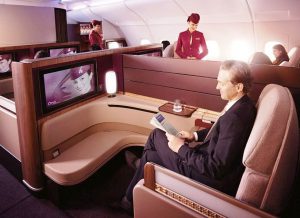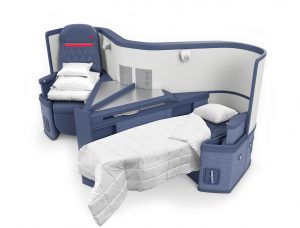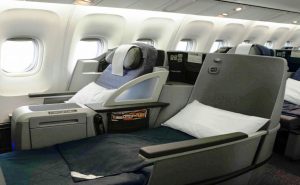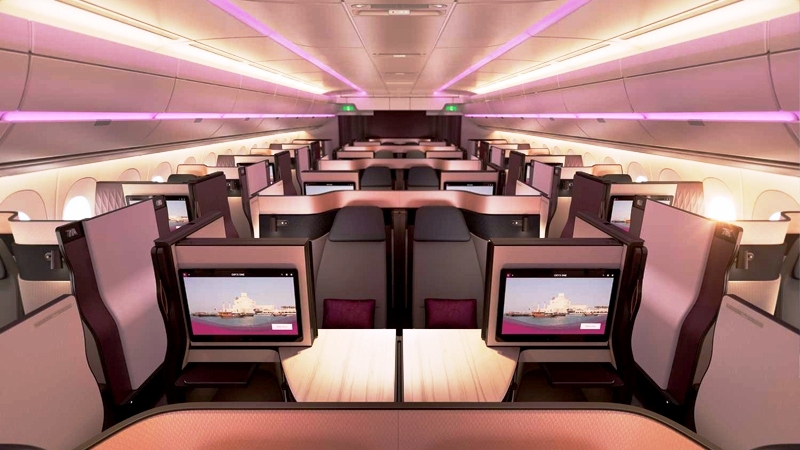As airlines compete for premium passengers, the gap between business and economy class continues to widen. On long flights, business class amenities make the trip more comfortable and convenient in many ways. Passengers get a better meal, more legroom, more attentive staff, and perks like warm towels, toiletries, and champagne on business class flights. Many major airlines are taking it even further, offering luxuries like privacy panels and complex entertainment systems.
New Aircraft Features
 Airlines offer seats that are completely horizontal when fully reclined. Customers say they’re as comfortable as a regular bed. For entertainment, business fliers enjoy private 15-inch screens and entertainment systems that provide hundreds of viewing options.
Airlines offer seats that are completely horizontal when fully reclined. Customers say they’re as comfortable as a regular bed. For entertainment, business fliers enjoy private 15-inch screens and entertainment systems that provide hundreds of viewing options.
Passengers can use privacy panels to screen themselves off from others. Some planes allow a few seats to be closed off together to form a mini-suite.
Qatar Airways offers the Qsuite, which allows four facing seats to be turned into either a single space for families or two double beds. Other airlines are purchasing similar models with different fittings and trim.
Carrier Costs
New seats cost airlines between $50,000 and $500,000 each. That’s a price carriers like Delta, Qatar Airways, and United Continental Holdings are willing to pay as they scramble to add luxury features. They also struggle to make room to accommodate luxury seats and usually do so by reducing space in coach.
 Airlines pay more than $20 million dollars every time they upgrade a wide body jet with new business class options. They see it as a way to remain competitive and define their brand in an increasingly tight market.
Airlines pay more than $20 million dollars every time they upgrade a wide body jet with new business class options. They see it as a way to remain competitive and define their brand in an increasingly tight market.
Airlines buy interior features directly from manufacturers like United Technologies Corp. and Rockwell Collins. The cost of reclining seats has continued to rise since they were first introduced in the 1990s. Seats on business class flights have up to 5,000 parts, each requiring complex testing at every stage of development.
Rigorous Testing Raises Cost
Everything installed on an airplane has to go through testing and certification, which dramatically increases the price of production. Regulations are constantly changing, and, when change happens, manufacturers sometimes have to go back to the drawing board.
Parts and features go through a crash test that simulates a crash landing. Manufacturers use a sled to test impact at 16 times Earth’s gravity. If parts fly off, they have to be redesigned.
 Rockwell Collins uses robots to simulate normal wear and tear by using objects over and over. For example, one robot might repeatedly set a 30-pound weight on a tray table to see how it holds up over time.
Rockwell Collins uses robots to simulate normal wear and tear by using objects over and over. For example, one robot might repeatedly set a 30-pound weight on a tray table to see how it holds up over time.
The company also hires seat testers to try out different models for comfort over several hours and repeated use. They show customers images of seats in a virtual cabin and ask for evaluations.
Testing doesn’t stop there. Airline officials, executives and flight attendants visit factories to evaluate designs. Manufacturers send samples to airlines, and many carriers offer seat testing as a perk for frequent fliers.
Business Class Airlines
Visit the below airlines’ websites to learn more about the amenities now being offered on business class flights.
Qatar Airways – https://www.qatarairways.com/en/onboard/business-class.html
Delta – https://www.delta.com/content/www/en_US/traveling-with-us/onboard-experience/delta-one-business-class.html
United – https://www.united.com/web/en-US/content/travel/inflight/business.aspx


